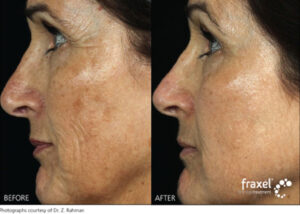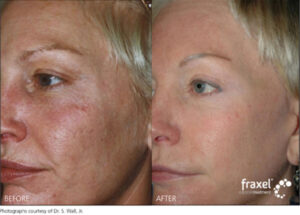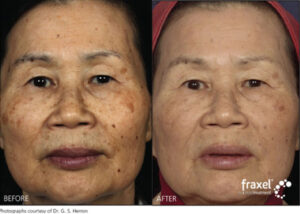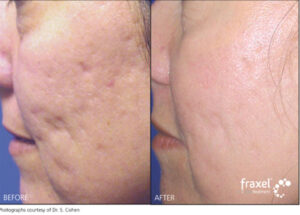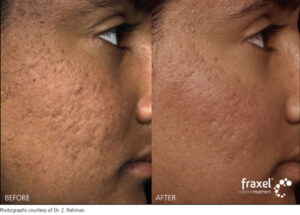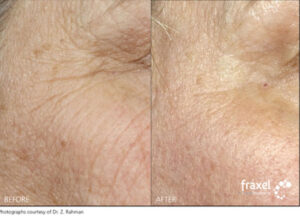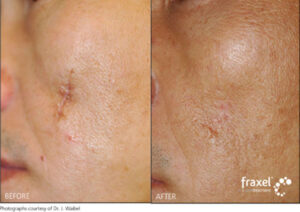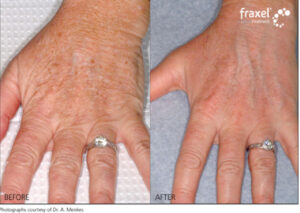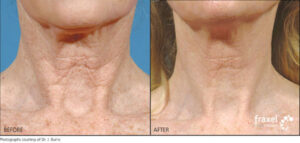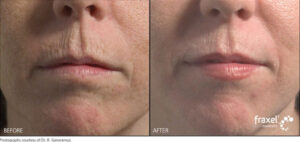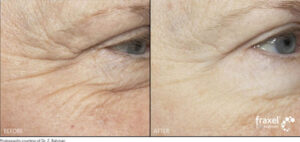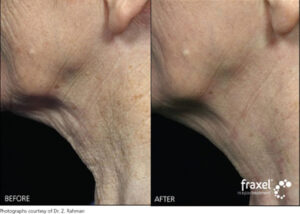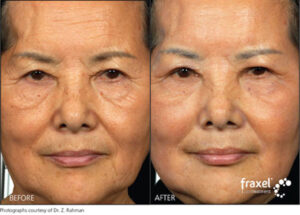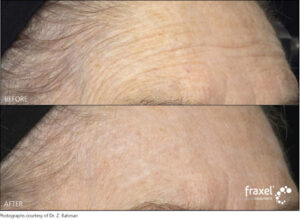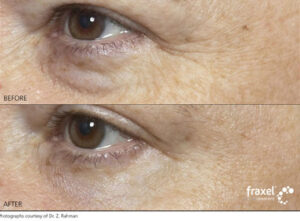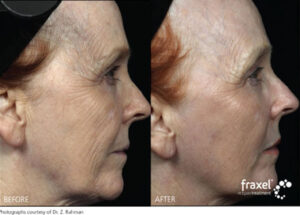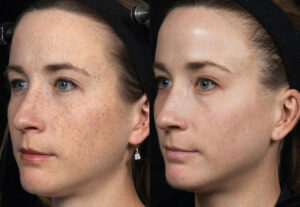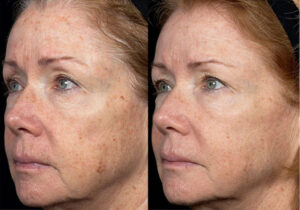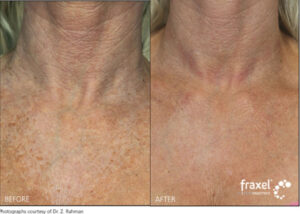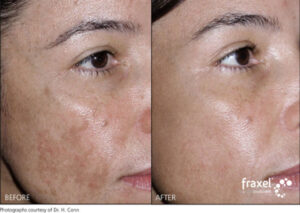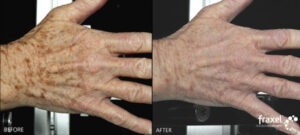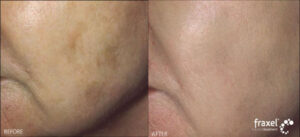FRAXEL® LASER Treatment
 Fraxel® was patented at Harvard University in 2003 and was the original landmark device that launched the new era of fractionated skin rejuvenation and scar treatment. It is considered to be a safe and relatively quick procedure that can minimise common signs of skin ageing. It creates smoother, fresher, and healthier skin, improves skin tone, texture, and pore size and softens wrinkles and lines. It also can be an excellent treatment for acne scars and surgical scars.
Fraxel® was patented at Harvard University in 2003 and was the original landmark device that launched the new era of fractionated skin rejuvenation and scar treatment. It is considered to be a safe and relatively quick procedure that can minimise common signs of skin ageing. It creates smoother, fresher, and healthier skin, improves skin tone, texture, and pore size and softens wrinkles and lines. It also can be an excellent treatment for acne scars and surgical scars.
Furthermore, work from Harvard is now starting to suggest that patients who have repeated fractionated treatments seem to develop fewer skin cancers and seem to express the signals of younger skin, so this technology may have a useful preventive effect.
Explore Topics On This Page
How Does Fraxel® Work?
The company behind Fraxel® pioneered an innovative technology known as fractional photothermolysis. This approach uses microscopically small beams of laser energy, each about one-tenth the diameter of a hair. The tiny islands of treated skin stimulate the body’s own natural healing to replace the old, damaged skin cells and collagen with normal, fresh, healthy-looking skin.
Fraxel® lasers work by only treating a fraction of the skin (15-50%) at each treatment session. This means the healing time is much quicker and the side effects significantly fewer than earlier full resurfacing techniques.
The Fraxel® laser also has a unique speed-dependent rolling delivery system that ensures that the laser lays down a uniform pattern of treatment to maximise effectiveness and reduce risk of overlapping. Most other laser devices treat one small area at a time and depend upon the operator being careful not to leave gaps between treatment areas and not to overlap, and therefore not to over-treat, areas.
Which Fractionated Laser Devices Work Best?
When the Fraxel® laser came onto the market, many rival laser manufacturers responded by launching their own version of fractionated lasers. However, the Fraxel® brand remains one of the best researched fractionated lasers and the safety and efficacy of the Fraxel® laser is well supported by published research.
Dermatology Consulting was one of the first and few dermatology clinics in the country to have both the Fraxel Restore and Fraxel Repair, and Dr Anne Farrell trained with some of the top expert users of this laser in the USA.
In summary, Fraxel® treatment can create smoother, fresher, younger-looking skin, close pores, reduce lines and wrinkles, and fade scars effectively.
Three wavelengths of Fraxel® Laser are available:
FRAXEL® RE:STORE Non-Ablative Laser with 1550nm Wavelength
This is the original Fraxel® laser treatment. It can rejuvenate damaged or tired-looking skin, giving you new, smoother, fresher, younger-looking skin. Fraxel® Re:store is usually delivered as a series of treatments. Our skilled team have considerable experience in using Fraxel® Re:store to treat:
- Wrinkles and fine lines
- Acne scars
- Surgical scars
- Age spots and sunspots
- Melasma and irregular pigmentation
About Fraxel® Re:store with 1550nm Wavelength
Fraxel® Re:store was launched in 2003, and this technology uses the high efficiency erbium glass laser (which uses the 1550 nm wavelength). This is a non-ablative treatment in that it does not break the surface of the skin, so there is usually a short recovery time, allowing you to return to work or other activities quickly.
Fraxel® Re:store usually requires several treatments for optimal results, and after each one the skin may be pink and slightly swollen. There is usually slight flaking of the skin a couple of days later, but as the skin is not broken, patients are often able to return to work the day after treatment.
What Problems Can Be Treated with Fraxel® Re:store with 1550nm Wavelength?
Fraxel® Re:store is designed to treat fine lines and wrinkles, skin irregularities, poor skin texture, enlarged pores, irregular skin pigmentation, and scars. It can also be used in combination with creams to treat melasma.
What Areas Can Be Treated with Fraxel® Re:store with 1550nm Wavelength?
Almost any site on the body can be treated, although the most popular areas are the face, neck, chest, and hands. It can be used safely on all skin colours, from very pale to very dark skin.
How Are Fraxel® Re:store Treatments Performed?
First, your skin will be cleansed. Then, about 60 minutes prior to the procedure, an anaesthetic ointment will be applied to the treatment area. Fraxel® Re:store therapy usually takes 20 to 25 minutes for a full face treatment.
Clinical studies suggest that in general, the most effective approach is to complete three to five sessions, which should be spaced about two to four weeks apart. Depending on your condition and schedule, you may choose to space treatment sessions further apart. Results should be visible immediately after treatment and continue to improve over time.
Does Fraxel® Re:store with 1550nm Wavelength Treatment Hurt?
Most patients describe a hot, prickling sensation during the treatment. To minimise discomfort, numbing (local anaesthetic) cream is applied approximately 60 minutes before beginning, and cold air blown onto the treatment area during the procedure. Afterwards, most patients feel like they have a sunburn, which usually diminishes in one to three hours.
What Should I Expect After Fraxel® Re:store with 1550nm Wavelength Treatment?
During the first 24 hours following the procedure, your skin may feel as if it has a sunburn, and it will look slightly pink or red. The skin is not broken so there is no bleeding. If you wish, you may apply makeup to reduce the appearance of these effects. The pinkness may last for a few days, and then your skin should develop more of a bronzed look over the next week or two. Each time you undergo this treatment, the sunburned-to-bronzed experience will also repeat. As is the case with a natural sunburn, your skin will likely flake and exfoliate normally. We recommend using a moisturiser to reduce the appearance of dryness and to limit flaking.
What Side Effects Can I Expect After Treatment and How Long Will They Last?
As well as pinkness, there may be some swelling. This reaction is usually mild and should subside within a few days. Other short-term effects may include minor itching in the treated area, dry skin, peeling, and/or flaking. Individuals prone to acne may experience a temporary flare-up, but this is usually brief and if wished, antibiotics or LED light can be prescribed to resolve this quickly. There is minimal risk of infection or scarring. The intensity and duration of any mild redness or swelling will vary depending on the aggressiveness of treatment as well as the patient’s unique rate of healing.
What Precautions Should I Take After Fraxel® Re:store with 1550nm Wavelength Treatment?
Your skin will heal more quickly and smoothly if you keep it well moisturised with a bland moisturiser for the first few days after treatment. You will also need to wear a broad spectrum sunscreen (at least factor 30 protection) every day for at least three months after the completion of the course of Fraxel® treatment.
How Long Do the Positive Effects of Fraxel® Re:store with 1550nm Wavelength Last?
The improvement to scars, skin texture, and wrinkles is long term, but it is advisable to protect your results with good sunblocks and skin care. For pigmentation and melasma in particular, it is very important to avoid direct sun exposure to avoid a recurrence. Observations by the team in Harvard who developed the Fraxel Re:store laser suggest that patients who have repeated fractionated lasers seems to develop less skin cancer which is an exciting development.
“Dr Farrell has been my dermatologist since I was a teenager when she helped me sort my acne. I've been coming here since then for all my skin rejuvenation procedures - fraxel laser and lumecca - and honestly wouldn't trust anyone else with my face! Dr Farrell is hugely qualified and she has a wonderful team working under her.”
FRAXEL® RE:PAIR CO2 Laser
What Is Fraxel® Re:pair?
Fraxel® Re:pair treatment, was launched in the UK in April 2008. Like some of the earlier powerful ablative laser resurfacing procedures, Fraxel® Re:pair laser treatment uses a high-intensity carbon dioxide (CO2) laser to vaporise unwanted tissue. However, unlike other ablative procedures, Fraxel® Re:pair treatment uses fractional technology to treat a fraction of the skin (10-50% of each treatment session). As a result, noticeable results can be achieved with dramatically faster recovery time in a single treatment. Because only a fraction of the skin is being treated, problems that could sometimes occur with the earlier full ablative treatments (i.e. prolonged redness, scars, and patchy loss of skin pigment) are avoided, typically making this a safer and reliable treatment.
Fraxel® Re:pair treatment uses thousands of microscopic laser beams to penetrate deep into the skin and remove old, damaged skin cells. Each area of laser-treated skin is surrounded by a large region of undamaged skin cells that serve to help replenish cells as the skin heals. Over about a week, the body’s own natural healing process gradually replaces the damaged tissue with glowing, healthy skin. Furthermore, because the technology is so precise, Fraxel® Re:pair treatment can work not only on the face, but also on delicate skin areas like the neck, chest, and hands.
What Concerns Can Fraxel® Re:pair Treat?
As you age, your skin loses its elasticity and collagen, becoming more prone to looseness, wrinkles, and broken thread veins. These changes are in part due to natural ageing but are worsened by environmental factors such as sun damage. Fraxel® Re:pair can soften fine lines, give a smoother complexion, close pores, reduce thread veins, and tighten the skin.
The treatment is designed to give your skin significant improvement, transforming its appearance and making you look younger. Furthermore, you can achieve dramatic results in a single treatment with faster recovery than earlier lasers or peels.
Fraxel® Re:pair can be used to treat:
- Wrinkles
- Irregular texture
- Age spots/sunspots
- Dilated pores
- Acne scars
- Surgical scars
- Stretch marks
What Are the Benefits of Fraxel® Re:pair Treatment?
- Significant results in a single treatment
- A pre-emptive strike against a facelift through skin tightening
- Improved skin tone and texture
- Softening of frown lines and wrinkles
- Tightening of pores
- Improvement of acne scars, surgical scars, and stretch marks
How Many Fraxel® Re:pair Treatments Will I Need and How Quickly Will I See Results?
Clinical studies suggest that for many patients, significant results can be achieved in a single treatment. The Fraxel® Re:pair treatment can be adjusted for the clinical need of the skin. Individuals with severe wrinkles or acne scars may need more than one treatment.
How Is Fraxel® Re:pair Treatment Performed and Does the Treatment Hurt?
First, your skin will be cleansed. About 60 to 90 minutes before treatment, a numbing (local anaesthetic) cream will be applied to the treatment area and pain relief medication given. You may also choose to take another medication to relax you. If the areas around the eyes are to be treated, lubricated eye shields (similar to contact lenses) are used to protect the eyes. Local anaesthetic injections are also used for additional temporary pain relief. Most patients describe the feeling during treatment as a sensation of heat, and there may be a small amount of discomfort. However, unlike the experience in earlier traditional CO2 treatments, you should feel quite comfortable as soon as the Fraxel® Re:pair treatment is over, although your skin will feel warm. The procedure takes approximately 30-40 minutes for the full face and 15 minutes for the area around the eyes.
What Precautions Do I Have to Take Before the Fraxel® Re:pair Treatment?
You will be given antiviral tablets and antibiotic tablets to start the night before the treatment and these are continued for up to 10 days to reduce the chance of infection.
What Should I Expect After Fraxel® Re:pair Treatment and What Are the Risks?
Depending upon the strength of your treatment, there might be some pinpoint bleeding and weeping for up to 48 hours until the tiny wounds close up. The most common side effects are redness and swelling, which should subside after a few days to a week.
Most of the redness settles in one week, although patients with very fair skin may be pink or flush easily for a few weeks, and this effect can be covered with make-up. Some other short-term side effects may include mild itching, dry skin, peeling or flaking, and a sunburned appearance as the skin heals. Some of these skin reactions may not occur with all patients.
The new skin is visible as the swelling and redness subsides, and the tightening and improvement should continue over the next six months.
Can This Fraxel® Re:pair Treatment Be Used with BOTOX® and Fillers?
Fraxel® Re:pair can be used as an alternative to BOTOX® injections (which relax the underlying muscles) and dermal fillers (which replace lost volume). Many patients, however, find it beneficial to use all three of these together, as they complement each other.
Who Should Not Have Fraxel® Re:pair Treatments?
Fraxel® Re:pair treatment should be avoided during pregnancy. There is little data at present on its use in very dark skin, so it is best avoided by individuals with this skin type. Fraxel® Re:pair should be approached carefully in people with a tendency to form thick scars (keloid scars), have recurrent cold-sores, or take photosensitising drugs.
Who Is an Ideal Candidate for Fraxel® Re:pair?
If you want to have smoother, tighter, younger-looking skin, you may be a good candidate. For patients who are 40-50 years old, this procedure can delay the need for a facelift. For those over 50 years, it can achieve many of the benefits of a facelift without a general anaesthetic and can be repeated if necessary. It can also significantly improve scars.
What Precautions Should I Take After Fraxel® Re:pair Treatment?
It is very important that you keep your skin well moisturised in the first few days after the procedure. You will be given healing ointment to use regularly. In the first few days, you will also need to soak the treated skin with antiseptic soaks every couple of hours to keep the skin clean of potential infection.
Once the skin has healed you should use a broad spectrum sunscreen of SPF 30 or higher and avoid direct sun exposure for at least three months to protect your new skin.
How Long Do the Positive Effects of Fraxel® Re:pair Treatment Last?
The results of Fraxel® Re:pair treatment typically will be instantaneous and progressive. Shortly after the procedure your skin’s surface should feel softer, appear more radiant, and reveal more even tone. Over the next three to six months there will be further improvement as the deeper layers of the skin continue to heal.
Dr Farrell was one of the first dermatologists to use the Fraxel® technology in the UK and she and her team have treated many hundreds of patients with these lasers. To find out more or book a consultation, we encourage you to contact us.
FRAXEL® RE:STORE WITH DUAL (1550nm and 1927nm) WAVELENGTH
What is Fraxel® DUAL?
Fraxel® DUAL is a more recent addition to the Fraxel® technology line, which was launched in the US in 2009 and in the UK in 2010. In addition to the 1550nm wavelength, it has an additional wavelength of laser energy called the thulium wavelength (1927nm). This wavelength of laser was previously used in other branches of medicine, but only recently has it been developed for use in dermatology. Fraxel® 1927nm is particularly good at removing pigment. One session with the thulium wavelength is equivalent to approximately four of the 1550nm wavelength for removing pigment.
Fraxel® DUAL treatment is usually performed with local anaesthetic cream, although some patients are able to have large areas treated without local anaesthetic. Afterwards, the skin may be red and slightly swollen and flaky for at least a week. Patients can wash as normal immediately after the treatment and apply makeup. Individuals who receive face treatments may wish to take a couple of days off work while the redness settles. A particularly popular treatment is to have the 1927nm thulium wavelength treatment first, to remove the unwanted pigment, then follow it up either on the same day or a couple of weeks later with the 1550nm wavelength, to help reduce wrinkles and improve skin texture.
What Are the Benefits of Fraxel® DUAL Treatment?
- Removal of brown spots and pigmentation
- Smoother, fresher-looking skin
- Improved tone and texture
- Reduced wrinkles, including around the eyes
- Improved appearance of acne scars and surgical scars
How Many Fraxel® DUAL Treatments Will I Need and How Will They Be Spaced?
Each person’s skin is unique, but clinical studies suggest that for most individuals looking for pigment improvement, the 1927nm (thulium) wavelength can give significant improvement in just one or two sessions. For individuals looking for improved texture and reduction of wrinkles and scars, maximum results can be attained in about three to five treatment sessions using the 1550nm (erbium glass) wavelength. Treatments are usually scheduled every two to six weeks.
Does Fraxel® DUAL Treatment Hurt?
A topical anaesthesia cream will usually be applied before beginning the procedure, and paracetamol can be taken. However, some patients are able to tolerate having large areas treated with the 1927nm wavelength without the need for local anaesthetic. During the procedure, cold air is applied to the treated area to minimise discomfort. After the treatment is complete, most patients report a feeling similar to having had too much sun. This sensation usually fades after one to three hours.
What Side-Effects Can I Expect After Fraxel® DUAL Treatment and How Long Will They Last?
There will be some degree of redness and swelling, depending on the settings chosen. After a few days there may be some slight peeling and flaking and sometimes a bronzed skin colouration. These effects can last different amounts of time depending on the treatment intensity and your particular healing characteristics.
What Precautions Should I Take After Fraxel® DUAL Treatment?
We recommend that you wear sunscreen of SPF 30 or higher and that you avoid direct sun exposure while you’re healing, and for at least two months after your last procedure. It is helpful to gain additional protection by wearing wide-brimmed hats if you expect to be outdoors.
How Long Do the Effects of Fraxel® DUAL Treatment Last?
The results of Fraxel® DUAL Treatment can last a long time, but the actual length of time will vary based on how you care for your skin and other factors unique to you. Once your skin has been improved, you should continue to protect it with a good skin care program and in particular good sun protection. This is particularly important when treating melasma.
Dr Farrell was one of the first dermatologists to use the Fraxel® technology in the UK and she and her team have treated many hundreds of patients with these lasers. To find out more or book a consultation, we encourage you to contact us.
